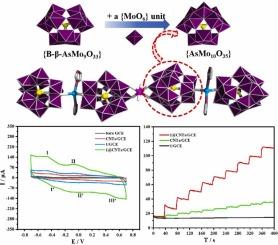Assembly of 1D organic-inorganic hybrid based on new arsenomolybdate ligand of [AsMo10O35]7− for efficient electrochemical sensing of hydrogen peroxide
IF 6.3
2区 材料科学
Q2 CHEMISTRY, PHYSICAL
引用次数: 0
Abstract
The rational design of electrocatalytic materials based on polyoxometalates represents an intriguing strategy towards high-sensitivity electrochemical sensing of H2O2. A novel arsenomolybdate-based organic-inorganic hybrid, H9(Him)15[Mn(H2O)2][AsMo10O35]2[Na(im)2]2[AsMo10O35]2·34 H2O (1) (im = imidazole), was obtained via a stepwise synthetic strategy. Structural analysis revealed that hybrid 1 features a one-dimensional (1D) chain comprising of alternating {Mn(H2O)2} and {Na(im)2} units linked to [AsMo10O35]7- clusters. In addition, hybrid 1 was combined with carbon nanotubes (CNTs) to fabricate a 1@CNTs composite, which was characterized by scanning electron microscopy (SEM), energy dispersive spectroscopy (EDS), infrared spectroscopy (IR), and electrochemical methods. Electrochemical studies reveal that hybrid 1 exhibited the multi-electron redox processes ascribed to MoVI centers, and had good electrocatalytic activity for H2O2 reduction. Due to the synergistic effect between hybrid 1 and CNTs, 1@CNTs modified electrode exhibited excellent analytical performance for H2O2 detection, with a high sensitivity of 0.2028 μA·μM−1, a low limit of detection of 1.47 μM (S/N = 3), as well as good anti-interference ability and stability. Furthermore, the 1@CNTs-based sensor was employed to detect H2O2 in human urine samples with a recovery of 98.76 %-100.17 %, demonstrating its feasibility for practical applications.

基于[AsMo10O35]7−的新型砷钼酸盐配体组装用于过氧化氢高效电化学传感的一维有机-无机杂化物
基于多金属氧酸盐的电催化材料的合理设计代表了一种对H2O2高灵敏度电化学传感的有趣策略。采用分步合成方法合成了新型砷钼酸盐基有机无机杂化物H9(Him)15[Mn(H2O)2][AsMo10O35]2[Na(im)2]2[AsMo10O35]2·34H2O (1) (im =咪唑)。结构分析表明,杂化物1具有由{Mn(H2O)2}和{Na(im)2}交替组成的一维(1D)链,与[AsMo10O35]7-簇相连。此外,将杂化物1与碳纳米管(CNTs)结合制备了1@CNTs复合材料,并通过扫描电镜(SEM)、能谱(EDS)、红外光谱(IR)和电化学方法对其进行了表征。电化学研究表明,杂化物1具有MoVI中心的多电子氧化还原过程,对H2O2还原具有良好的电催化活性。由于杂化1和CNTs之间的协同作用,1@CNTs修饰电极对H2O2检测具有优异的分析性能,灵敏度为0.2028 μA·μM-1,检测下限为1.47 μM (S/N=3),抗干扰能力和稳定性良好。利用1@CNTs-based传感器对人体尿液样品中的H2O2进行检测,回收率为98.76% ~ 100.17%,证明了该传感器在实际应用中的可行性。
本文章由计算机程序翻译,如有差异,请以英文原文为准。
求助全文
约1分钟内获得全文
求助全文
来源期刊

Journal of Alloys and Compounds
工程技术-材料科学:综合
CiteScore
11.10
自引率
14.50%
发文量
5146
审稿时长
67 days
期刊介绍:
The Journal of Alloys and Compounds is intended to serve as an international medium for the publication of work on solid materials comprising compounds as well as alloys. Its great strength lies in the diversity of discipline which it encompasses, drawing together results from materials science, solid-state chemistry and physics.
 求助内容:
求助内容: 应助结果提醒方式:
应助结果提醒方式:


